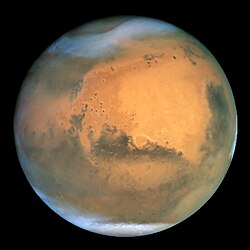Merkuriuspassage (Mars)

Merkuriuspassage från Mars benämns det som inträffar när planeten Merkurius passerar framför solen sett från Mars. Merkurius kan då ses som en liten svart skiva som långsamt rör sig över solens yta. Merkuriuspassager sedda från Mars är mer vanligt förekommande än Merkuriuspassager från Jorden, då de från Mars kan ses flera gånger på ett årtionde.
Passager 2000–2100
| 18 december 2003 | 13 juli 2044 | 12 januari 2084 |
| 12 januari 2005 | 24 maj 2045 | 22 november 2084 |
| 23 november 2005 | 8 november 2052 | 9 maj 2092 |
| 10 maj 2013 | 3 december 2053 | 3 juni 2093 |
| 3 juni 2014 | 14 oktober 2054 | 14 april 2094 |
| 15 april 2015 | 25 april 2063 | |
| 25 oktober 2023 | 6 mars 2064 | |
| 5 september 2024 | 27 juli 2073 | |
| 26 januari 2034 | 22 augusti 2074 | |
| 21 februari 2035 | 17 december 2082 |
Referenser
- Den här artikeln är helt eller delvis baserad på material från engelskspråkiga Wikipedia, Transit of Mercury from Mars, 4 september 2015.
Externa länkar
| |||||
| ||||||||||||||||||||||||||||||||||||||||||||||||||||||||
Media som används på denna webbplats
NASA's Hubble Space Telescope took the picture of Mars on June 26, 2001, when Mars was approximately 68 million kilometers (43 million miles) from Earth — the closest Mars has ever been to Earth since 1988. Hubble can see details as small as 16 kilometers (10 miles) across. The colors have been carefully balanced to give a realistic view of Mars' hues as they might appear through a telescope. Especially striking is the large amount of seasonal dust storm activity seen in this image. One large storm system is churning high above the northern polar cap (top of image), and a smaller dust storm cloud can be seen nearby. Another large dust storm is spilling out of the giant Hellas impact basin in the Southern Hemisphere (lower right).
Mercury Passes in Front of the Sun, as Seen From Mars
http://www.jpl.nasa.gov/news/news.php?release=2014-183
http://www.jpl.nasa.gov/spaceimages/details.php?id=PIA18389
http://www.jpl.nasa.gov/video/?id=1309 => Video
This animated blink comparison shows five different versions of observations that NASA's Curiosity made about one hour apart while Mercury was passing in front of the sun on June 3, 2014. This animated blink comparison shows five versions of observations that NASA's Curiosity made about one hour apart while Mercury was passing in front of the sun on June 3, 2014. Two sunspots, each about the diameter of Earth, also appear, moving much less than Mercury during the hour.
June 10, 2014
NASA's Curiosity Mars rover has imaged the planet Mercury passing in front of the sun, visible as a faint darkening that moves across the face of the sun.
This is the first transit of the sun by a planet observed from any planet other than Earth, and also the first imaging of Mercury from Mars. Mercury fills only about one-sixth of one pixel as seen from such great distance, so the darkening does not have a distinct shape, but its position follows Mercury's expected path based on orbital calculations.
The observation by the telephoto camera of Curiosity's two-eyed Mast Camera instrument is available online at:
http://www.jpl.nasa.gov/video/?id=1309
"This is a nod to the relevance of planetary transits to the history of astronomy on Earth," said Mark Lemmon of Texas A&M University, College Station, a member of the Mastcan science team. "Observations of Venus transits were used to measure the size of the solar system, and Mercury transits were used to measure the size of the sun."
The observations were made on June 3, 2014, from Curiosity's position inside Gale Crater on Mars. In addition to showing the Mercury transit, the same Mastcam frames show two sunspots approximately the size of Earth. The sunspots move only at the pace of the sun's rotation, much slower than the movement of Mercury.
Many viewers on Earth observed a Venus transit in June 2012, the last visible from Earth this century. The next Mercury transit visible from Earth will be May 9, 2016. Mercury and Venus transits are visible more often from Mars than from Earth, and Mars also offers a vantage point for seeing Earth transits. The next of each type visible from Mars will be Mercury in April 2015, Venus in August 2030 and Earth in November 2084.
NASA's Mars Science Laboratory Project is using Curiosity to assess ancient habitable environments and major changes in Martian environmental conditions. NASA's Jet Propulsion Laboratory, a division of the California Institute of Technology, Pasadena, built the rover and manages the project for NASA's Science Mission Directorate in Washington.
For more information about Curiosity, visit http://www.nasa.gov/msl and http://mars.jpl.nasa.gov/msl/. You can follow the mission on Facebook at http://www.facebook.com/marscuriosity and on Twitter at https://twitter.com/marscuriosity.
Guy Webster Jet Propulsion Laboratory, Pasadena, Calif. 818-354-6278 guy.webster@jpl.nasa.gov
2014-183

